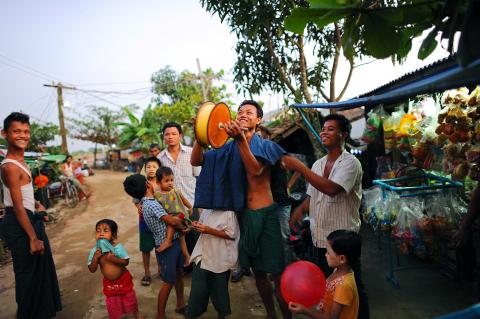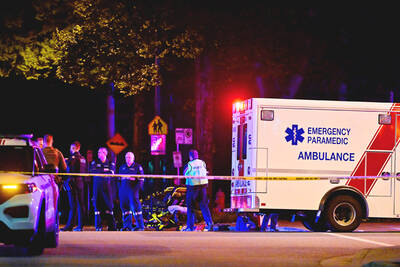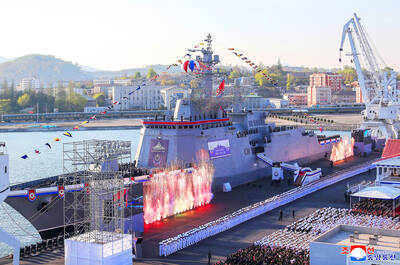Myanmar’s trumpeted reforms are yet to trickle down to Yangon’s poor, rubbish-strewn slums, where experts say residents’ frustrations could turn ugly if the benefits of change are not felt soon.
Each month the bamboo shacks of Shwe Paukan are inundated when high tides overflow from the river running parallel to the slum.
The clean-up after the knee-deep waters recede leaves little time for optimism over a reform process that has brought greater political and economic openness to Myanmar, but few signs that the lives of the poorest are about to improve.

Photo: AFP
“We have not felt the change that everyone is talking about,” said Ni Ni Win, 27, a mother of two. “I think it has happened among the upper level of the society.”
It is an increasingly common concern and one US President Barack Obama touched on during his milestone Nov. 19 trip to the former junta-ruled country, where he hailed the “remarkable” pace of change, but warned reforms must not bypass the poor.
Ni Ni Win, who earns about US$3 a day at a plastic recycling plant, is to a degree fortunate to live in her slum in Yangon, where an estimated two million people live in poverty.
A few kilometers away, near the city center, 400 to 500 people live in Aung Mingalar, an illegal settlement shoehorned between a river and a storage area for teak logs, which also serves as an open toilet.
The slum is desperately poor — the earth is studded with rubbish and clothes are hung out to dry on barbed wire.
Amid the squalor residents eke out a few dollars by putrefying fish guts in barrels and selling the leftover oil to chicken farmers.
Ko Ko, 46, said he lives in constant fear his family are to be expelled from their home.
“We are not living here because we want to, but because we have no choice … we can’t pay for a place to live,” he said.
Ko Ko provides for six people from the income from his small grocery stall.
“The biggest challenge for us here is food. Every morning people have to struggle for food,” he said.
The UN agency for human settlements (UN-HABITAT) estimates that at least 40 percent of Yangon’s five million people are “poor or extremely poor,” surviving “day to day,” often in substandard housing or illegal dwellings.
“Nothing has been done in 20 years,” according to Michael Slingsby, the body’s urban development and poverty adviser.
With the city’s population expected to double to about 10 million over the next 20 to 25 years, Myanmar’s government will come under increasing pressure to tackle poverty or face mounting discontent among the urban poor.
They are a section of society often neglected by foreign donors, Slingsby said, in a nation where a quarter of the population lives below the poverty line — the majority in rural areas.
After more than a year of dramatic political change that has helped the country out of international isolation, Burmese President Thein Sein has promised a second wave of reform focused on the economy, with the aim of slashing the poverty rate to 16 percent by 2015.
It is an “ambitious” goal, says Sean Turnell, an economist at Macquarie University in Sydney, backing Myanmar’s potential to achieve rapid growth and simultaneously reduce poverty.
That will only be possible with “a focus on agriculture,” he says, calling for far-sighted policy to boost a sector which provides a living for the vast majority of Myanmar’s people.
The government has been widely praised for major economic initiatives, including unifying multiple exchange rates, and enacting a foreign investment law.
However, experts warn that social unrest may lie ahead if the benefits of reform do not trickle down, and fast, to the country’s most disadvantaged.
“This is potentially one of the major issues the reform process may have to face,” Slingsby said.
“Manifestations of discontent with poverty will take place,” said Win Htein, a lower-house MP from Aung San Suu Kyi’s National League for Democracy, predicting frequent protests as democracy is embedded.
“But they [protests] cannot reach the stage of threatening the government.”

Archeologists in Peru on Thursday said they found the 5,000-year-old remains of a noblewoman at the sacred city of Caral, revealing the important role played by women in the oldest center of civilization in the Americas. “What has been discovered corresponds to a woman who apparently had elevated status, an elite woman,” archeologist David Palomino said. The mummy was found in Aspero, a sacred site within the city of Caral that was a garbage dump for more than 30 years until becoming an archeological site in the 1990s. Palomino said the carefully preserved remains, dating to 3,000BC, contained skin, part of the

TRUMP EFFECT: The win capped one of the most dramatic turnarounds in Canadian political history after the Conservatives had led the Liberals by more than 20 points Canadian Prime Minister Mark Carney yesterday pledged to win US President Donald Trump’s trade war after winning Canada’s election and leading his Liberal Party to another term in power. Following a campaign dominated by Trump’s tariffs and annexation threats, Carney promised to chart “a new path forward” in a world “fundamentally changed” by a US that is newly hostile to free trade. “We are over the shock of the American betrayal, but we should never forget the lessons,” said Carney, who led the central banks of Canada and the UK before entering politics earlier this year. “We will win this trade war and

‘BODIES EVERYWHERE’: The incident occurred at a Filipino festival celebrating an anti-colonial leader, with the driver described as a ‘lone suspect’ known to police Canadian police arrested a man on Saturday after a car plowed into a street party in the western Canadian city of Vancouver, killing a number of people. Authorities said the incident happened shortly after 8pm in Vancouver’s Sunset on Fraser neighborhood as members of the Filipino community gathered to celebrate Lapu Lapu Day. The festival, which commemorates a Filipino anti-colonial leader from the 16th century, falls this year on the weekend before Canada’s election. A 30-year-old local man was arrested at the scene, Vancouver police wrote on X. The driver was a “lone suspect” known to police, a police spokesperson told journalists at the

North Korean leader Kim Jong-un has unveiled a new naval destroyer, claiming it as a significant advancement toward his goal of expanding the operational range and preemptive strike capabilities of his nuclear-armed military, state media said yesterday. North Korea’s state-run Korean Central News Agency (KCNA) said Kim attended the launching ceremony for the 5,000-tonne warship on Friday at the western port of Nampo. Kim framed the arms buildup as a response to perceived threats from the US and its allies in Asia, who have been expanding joint military exercises amid rising tensions over the North’s nuclear program. He added that the acquisition